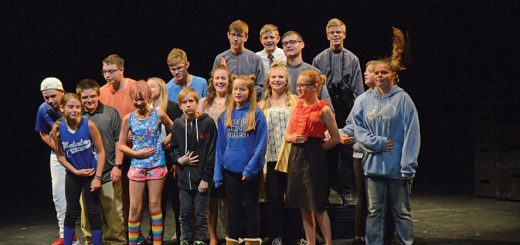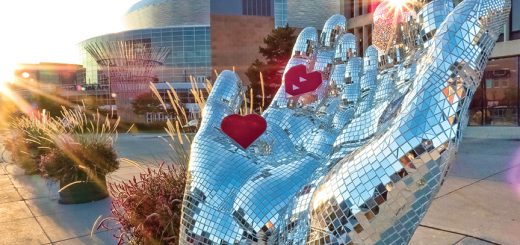Fiber Art: Across the World —Across Time

by Laura Chapman
With quilts and textiles from more than 50 countries—and counting—the International Quilt Study Center & Museum’s 2019 exhibition calendar will highlight its expanding global collection and research.
Beginning in Winter 2019, two exhibitions will showcase quiltmaking and related traditions from Africa. From Kente to Kuba: Stitched Textiles from West and Central Africa, Dec. 7– May 12 and Stitching the Transatlantic: Liberian Quilts from the John Singler Collection, Jan.18 – June 16 are the museum’s first two major exhibitions showcasing work from the continent.
“These exhibitions put quiltmaking into a larger global context,” said Marin Hanson, curator of international collections. “They show the relationship between what we are most familiar with in terms of American quilts and links them with the larger world of textile creation.”
From Kente to Kubawill display recently acquired textiles from Ghana, Nigeria and the Democratic Republic of the Congo. Dating from the early to late 20th Century, most of the featured textiles are not quilts, meaning they do not consist of two or more layers joined together with stitches. Instead, they display techniques similar to those used in quiltmaking, including patchwork and appliqué.
As with other forms of material culture from around the world, many of the featured textiles are ceremonial and contain symbolism significant to the makers. For example, an egwugwumade by the Igbo people of Nigeria is believed to connect the wearer with tribal ancestors.
“The costume provides a link to the past for the Igbo people,” Hanson said. “It links them to their ancestors in a very direct way, but it also allows us to learn more about the history and culture of this group.”
The exhibition will also include quilts made during the past two decades. These pieces represent a hybrid product combining traditional Nigerian indigo resist-dyed fabrics—adire—with American-style quilt patterns and formats. These quilts are typically made to be sold to tourists.
Similarly, Stitching the Transatlanticshowcases the quiltmaking practices of Liberia, which came to that country via its original 19th-Century settlers, freeborn blacks and freed slaves from America. The exhibition’s group of late-20th Century quilts demonstrate how today’s makers create pieces from local and imported fabrics with designs ranging from ones found in American traditions to ones that represent the scenery, fashion and politics of their homeland.
“The very direct influence of American quilts on this tradition in Liberia is instructive,” Hanson said. “It isn’t just a concept or theory of cross-cultural interaction. It’s a very real example of how quiltmaking can migrate along with its practitioners.”
The exhibition is guest curated by art historian Stephanie Beck Cohen with pieces borrowed from New York University linguistics professor John Singler’s personal collection.
South Asian Stories: Daily Life and Quiltmaking in Western Indiawill highlight the museum’s extensive collection of quilts made in Gujarat, Maharashtra and Karnataka. By collaborating with researchers and collectors in the field, the museum has expanded its collection and more importantly, has gathered information about the quilts’ makers.
“A lot of times when we see objects, especially ethnographic objects from other parts of the world, we think of them as being anonymously made,” Hanson said. “In this case, many of the pieces were collected directly from the creator. We know their stories. We now can provide a richer, more in-depth look at the quilts and their makers than you would ordinarily have in an exhibition like this.”
In addition to representing the museum’s global focus, these exhibitions also show the impact of migration on quiltmaking traditions. For instance, the works in From Kente to Kubaare from the African regions historically most affected by the slave trade, a form of forced migration.
Stitching the Transatlanticdisplays quilts made by former slaves upon their migration to Africa. And several works in South Asian Storieswere made by members of the Siddi ethnic group, who descended from Africans forced to migrate to western India as slaves or mercenary soldiers. Gaining a more holistic, multifaceted view of how migration and textiles of the African diaspora relate to quilts is a major benefit of presenting multiple exhibitions with unified themes.
“It reinforces, for me, the motivation I have for studying quilts,” Hanson said. “They can represent human interaction and human interface. People learn from each other and connect. Migration isn’t always wonderful. Forced migration is one of the worst legacies of our shared human experience. But wonderful things can happen when people come together. It is important to learn about the good and the bad.”
This theme will also be reflected in Los Desconocidos: Migrant Quilts, March 25 – June 27. The works in this exhibit, on loan from the Migrant Quilt Project founded by Jody Ipsen, features quilts made from materials collected from unidentified migrants who died in Arizona’s Sonoran Desert. The quilt project documents deaths since 2000 in fabric collages that blend the narrative with folk art traditions.
Other exhibitions on display at the quilt museum in 2019 include:
• New Views: Icons and Outliers, May 17 – Oct. 13
• Old World Quilts, June 21 – Nov. 30
• Emiko Toda Loeb: Dual-Sided Quilts, July 5 – Oct. 27
• Nancy Crow, Aug. 2 – Jan. 9, 2020
• Snowflakes and Crystals, Oct. 18 – March 29, 2020
• Diana Harrison, Nov. 1 – April 26, 2020
The International Quilt Study Center & Museum is located at 33rd and Holdrege streets on the University of Nebraska-Lincoln’s East Campus. Home to the world’s largest publicly held quilt collection, the museum’s mission is to build a global collection and audience that celebrate the cultural and artistic significance of quilts. For more information about exhibition, programs and admission, visit www.quiltstudy.org.














Recent Comments